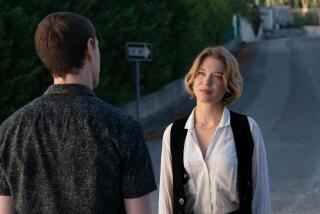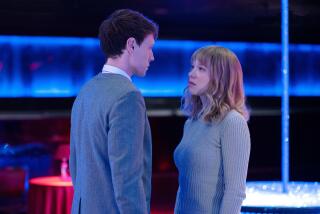Review: The Philip Glass effect on film: Transforming ‘Dracula’ and ‘Beauty and the Beast’
Director Brett Morgen said recently on former Los Angeles Times columnist Robert Scheer’s podcast, “Scheer Intelligence,” that maybe it hadn’t been such a hot idea to premiere his new documentary, “Jane,” with Philip Glass’ soundtrack played live at the Hollywood Bowl a couple weeks ago. All those months of meticulous sound editing were thrown out the window by having an actual orchestra onstage.
That’s a peculiar, even somewhat obnoxious argument, but it’s not new and it’s understandable. Glass’ extensive relationship to film ranges from unobtrusive background noodling to treating celluloid and its digital manifestations as performative material, as theater and even opera. A film director, on the other hand, is by job description a control freak. It can’t always work.
The inherent collaboration or conflict between any composer and director might help explain why Glass has turned to two cinema classics: Tod Browning’s 1931 “Dracula,” starring Bela Lugosi, and Jean Cocteau’s beloved “La Belle et la Bête” (Beauty and the Beast) from 1946. By curious coincidence, both could be encountered, back-to-back, over the weekend.
The Philharmonic Society of Orange County and the Segerstrom Center for the Arts presented “Dracula” on Saturday night, with Glass himself on keyboards, joining the Kronos Quartet, for whom he wrote the film’s new score. On Sunday afternoon at the Theatre at Ace Hotel, Los Angeles Opera presented the second of its three performances of “La Belle et la Bête,” the opera Glass wrote to be sung and played along with the picture (the original soundtrack — and all its sound editing effort — discarded).
In one sense, this might seem like a pushy composer simply taking over these movies, their directors no longer able to talk back. And don’t think that that hasn’t outraged cineastes and critics who admire the original artistry of both films. But in another sense, what Glass has done is what theater artists and musicians do, which is to make everything at their disposal newly alive for the moment. That should actually go down pretty easily in our age of DJs and free internet when everything is material for refashioning. Plus, thanks to new technology that makes it easy to remove film scores from the soundtrack and that permits films to be vividly projected in concert halls, the trend of screening everything from musicals to “Star Wars” with live orchestral accompaniment has caught on big time.
Glass, however, goes a step further. For all a director’s authority, film is the most collaborative art form, and Glass is surely the most collaborative artist in history. His dozens of movies are only a small part of his prolific output, which includes music for well over 50 operas, dance works and music theater pieces; 11 symphonies; hoards of concertos and other orchestra and chamber pieces. All that and the reams of music for the Philip Glass Ensemble, which he founded 49 years ago and is still going strong, as it demonstrated at the Ace on Sunday.
The range of collaborations that all these projects have involved over a six-decade career — Glass turned 80 in January — is almost beyond belief. And much of it has come from a stubborn theatrical impulse to find new ways of doing things. Glass’ style may not change much, if at all, from piece to piece, but it definitely evolves over time, and the context is never the same.
In “Dracula” and “Belle,” the picture is not something to be accompanied but transformed into performance pieces. Both are projects from the 1990s, when they seemed radical, but they’ve now become classics in their own right, regularly trotted out. Within the last three years, the Glass Ensemble has brought “Belle” to UCLA, and Kronos has brought “Dracula” to the Ace.
Seeing them together reinforces how much cinema once did rely on theater and sometimes opera, something lost in the manufactured sensory overload escapism (fascism?) practiced in modern movie theaters — eyes dazzled by 3-D CG imagery, ears deafened by vehement surround sound, mouths stuffed with popcorn, fingers busy texting.
“Dracula” has both a polished look (the slick actors) and a very artificial one, with its painted backdrops that appear snatched from the stage. Originally, Glass had the live performers sit behind the screen, visible through it and thus part of the picture (which horrified some film buffs). At Segerstrom on Saturday, Kronos, Glass and Mick Rossi, the second keyboard who also conducted, sat below the screen but were lighted and always visible.
At one point, Glass in his glasses looked like a doppelgänger of Professor Van Helsing, the European scholar of the occult who is responsible for handling Count Dracula. More striking was the way that Glass’ score transformed Lugosi’s Dracula from a camp visage into the kind of disturbing character — in whom charm and menace mingle indistinguishably — you find in a Robert Wilson production. Suddenly, this old film has something new and meaningful to say.
The whole point of Cocteau’s “Belle” is formal artifice, the stylized Beast, the gorgeous costumes, the magic castle with living fixtures. All of this takes on a completely different aspect as well, what with Glass having removed dialogue and Georges Auric’s lovely original score replaced by four impressive singers (Gregory Purnhagen, Hai-Ting Chinn, Marie Mascari and Peter Stewart) and the Glass Ensemble, again seen under the screen.
The characters in the movie are the same as the characters in the opera. Your brain, though, needs to develop new synapses to process that. What first seems to take the artificiality of opera too far eventually gives the film new magic through the transformative power of music.
I wasn’t able to attend the Hollywood Bowl screening of “Jane.” Anything can happen, and maybe did, with live performance. But the movie is in the can, and it’s worth finding out what happens when you let it out now and then, even if that turns out to be a horror like Dracula stepping out of his coffin at night or the miracle of a prince freed from his imprisonment in the body of a beast.
♦ ♦ ♦ ♦ ♦ ♦ ♦ ♦ ♦ ♦
L.A. Opera’s ‘La Belle et la Bête’
Where: The Theatre at Ace Hotel, 929 S. Broadway, L.A.
When: 8 p.m. Tuesday
Tickets: $25-$114
Info: (213) 972-8001 or LAOpera.org
ALSO
Susanna Mälkki and the Los Angeles Philharmonic
Garth Fagan Dance delivers new spirit-lifting work
Guillermo Calderon’s ‘Mateluna’ at REDCAT
More to Read
The biggest entertainment stories
Get our big stories about Hollywood, film, television, music, arts, culture and more right in your inbox as soon as they publish.
You may occasionally receive promotional content from the Los Angeles Times.







